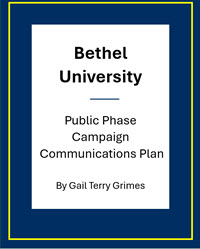Communication Plans
Enthusiastic support for your cause is all about relationships, and relationships are all about communication. You could forge ahead without a plan, but there’s too much at stake. You need:

|
|
|
- A road map to guide your leaders, staff, and volunteers in communicating and reinforcing all your agreed-upon messages to all your relevant audiences.
- A calendar and work schedule
- Never miss an opportunity to promote your organization’s vision and priorities.
- Keep communication top of mind for the whole team. Avoid misunderstandings.
- Meet deadlines. Exceed expectations.
- Clear roles. A good plan should confirm who exactly is responsible—which office, which individuals—for creating, reviewing, approving, and distributing each deliverable. Staff will use this information to support smooth operations and a spirit of collaboration.
- Professionalism and continuity. When these elements are present in your messaging and style, your audience feels reassured.
- Maximum impact from less effort. You know who really appreciates a communication plan? New hires. Nothing shortens their learning curve like a well-crafted plan.
A good communication plan covers all the bases.
Key Messages (What do you want to say?)
- Your organization’s brand statement
- Your organization’s unique value proposition in one sentence
- Key messages about your organization and its plans
- Key messages related to specific funding priorities.
Audiences (Who do you want to reach?)
- Who are the audiences within your organization’s “family?”
- Who are the audiences beyond your organization’s “family?”
Communication Chennels (How will you reach them?)
- Not just a list (e.g., annual report, monthly newsletter), but a brief summary of each channel’s audience(s), type(s) of content, distribution method(s), timeline, and other pertinent details. Be sure to add any channels—and audiences—you’ve been meaning to add; you’ll be more likely to do it if it’s part of the plan.
Timeline (When will you reach out to each audience?)
- A one-year quarterly calendar is a good place to start.
Strategies
- It takes skill to whittle down all the ideas to three (or maybe five) key strategies.
Tactics
- Aim for five or more tactics per strategy.
Communication Team
- A good communication plan will include a spreadsheet listing everyone at your organization who has direct responsibility for at least one aspect of communication. Include the nature of their responsibility (e.g., Social Media) and their contact information. Use this spreadsheet to specify who needs to sign off on each communication project. Who will do the work, and who has the final say—on text, photos, and design?
How's your communication plan coming? Contact me (Gail Terry Grimes) to talk about what it will take to create your communication plan.